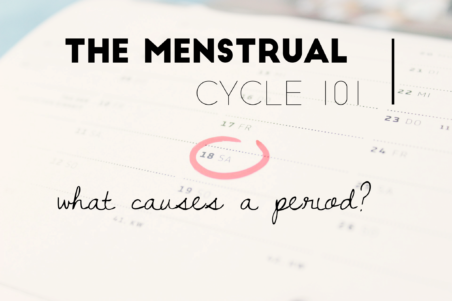The mystery of menstruation. I find it truly fascinating that as women we have the capacity to grow and shed a lining every month. That our cycle can also sync with other women’s cycles (much to the dismay of Dads with a house of girls) and we can also grow a human inside of us! How cool, right?
Although I do not love my period, being without one for five years made me have such a deep appreciation for the femininity that being in sync and on cycle brings, even if I might induce some serious cramping within myself from time to time. It is easy to hate on your monthly visit but I urge you to learn a little bit about it. The menstrual cycle is like our monthly report card, you can learn so much about your health when you understand it!
What causes menstruation?
It is now widely accepted that the menstrual cycle involves two main components, one a self limiting inflammation, and two a drop in progesterone that triggers the cascades.
Simply put, during the menstruation phase, the endometrial lining is shed. What we believe is that tissue swelling and an influx of different immune cells into the endometrial lining occurs. Then as the corpus luteum fails (due to a number of other mechanisms) we see a decrease in progesterone levels, kicking things into gear.
The dropping of progesterone leads to an increased synthesis of prostaglandin E2 (PGE2) and prostaglandin F2α (PGF2α) by upregulating COX-21. I bring up COX-2 here only because it is helpful to understand that Advil actual blocks this to decrease prostaglandins, and therefore pain and heavy bleeding…. Ding ding ding, it’s all coming together right?
Okay, back on track. So the pain that we have been discussing during menstruation may occur due to the potent vasodilating effect of PGE2, which increases edema or swelling. PGE2 and Interleukin-8 (CXCL8) work together to change the way fluid moves around your uterus and also increases the accumulation of neutrophils, a white blood cell and yet another inflammatory cell1. The dropping of Progesterone also induces inflammatory effects by inducing NF-κB. But before the menstruation phase, progesterone controls the endometrial inflammation by suppressing NF-κB activity (this is important when considering fertility).
All in all, some pain during the menstruation phase, known as primary dysmenorrhea, is quite normal although it should not be debilitating!
Primary dysmenorrhea is most common in teenagers. If you are a woman who has had normal periods for years and then, wham, began to develop unbearable menstrual pain it may be important to consider some of other possible causes, outside of simple inflammation. These include endometriosis, adenomysosis, fibroids, copper IUDs, pelvic inflammation disease, sexually transmitted infections and stress or HPA-D. If you have debilitating menstrual pain it is important to get checked out!
Cortisol and Your Menstrual cycle
One of the interesting things about menstruation is that it is a is a self-limiting inflammatory process, it just comes and goes on its own. 11β hydroxysteroid dehydrogenase-1 enzyme secretion is induced by pro-inflammatory cytokine IL-1 and assists in the conversion of cortisone to the anti-inflammatory steroid cortisol production. This mechanism helps to resolve endometrial inflammation. Women with heavy bleeding with prolong menses may have a decreased level of cortisol or increase level of 11βHSD-2 (responsible for the conversion of cortisol back to cortisone)1.
As you can see now, the stress I spoke of is a double whammy because it not only lowers the anti-inflammatory cortisol, but it also alters progesterone levels! This is one of the reasons that period cramps can be soo persistent in today’s day and age.
Menstrual Blood
Have you ever wondered what the heck your menstrual fluid was made up of? Let’s be honest, maybe not, but given my inquisitive nature of course I have!
The menstrual blood is a fluid made up of blood, vaginal discharges, endometrial cells of the uterine wall and number of proteins, which include histones, cytokines, enzymes, immunoglobulins and cytoskeletal elements2. Recent research also found menstrual blood-derived stem cells and they may possess potential clinical benefits1. Random aside, I think that this will be the next frontier in Medicine! Could we cure infertility, cancer, or end suffering, from menstrual fluid? I hope so!
The normal menstrual flow is also about 30ml of blood volume lost during the entire shedding cycle. In some cases though it may exceed up to 80 ml or more, this is known as menorrhagia or heavy bleeding.
What was your grade?
I hope that this article inspired you to use your period as a report card. Were you more stressed this month? Did you eat more sugar or inflammatory foods? Well you might have a rougher go with period cramps.
Have you noticed any correlation between your monthly activities and your period? Let me know, I will be answer questions next week, right here on the blog, and also on Facebook in the comments!
PS- Don’t forget to check out the other posts in this series! What is cervical mucus? What is the follicular phase? What is a normal period?
References
- Maybin, J. A. & Critchley, H. O. D. Menstrual physiology: implications for endometrial pathology and beyond. Hum. Reprod. Update 21, 748–61 (2015).
- Yang, H., Zhou, B., Prinz, M. & Siegel, D. Proteomic Analysis of Menstrual Blood. Mol. Cell. Proteomics 11, 1024–1035 (2012).

